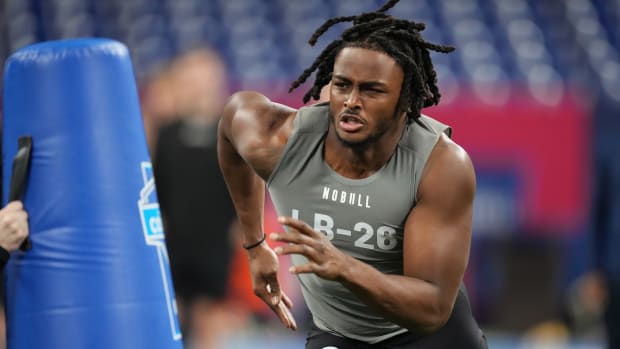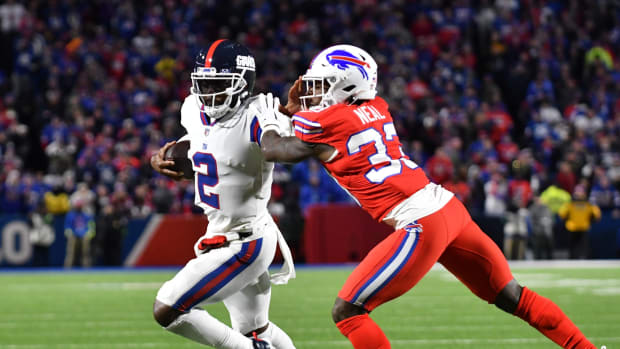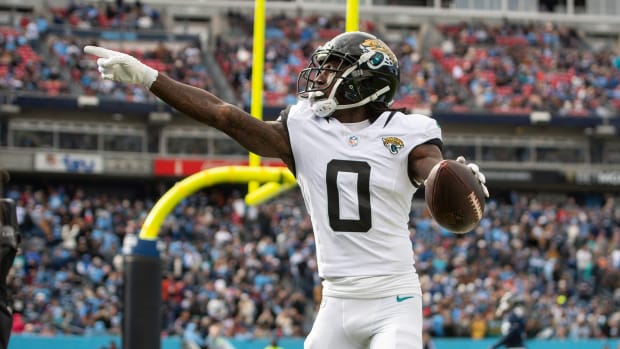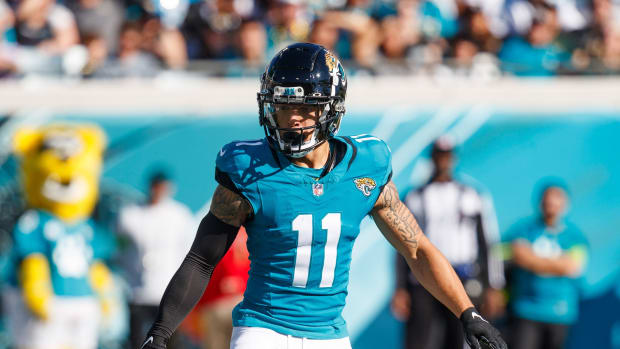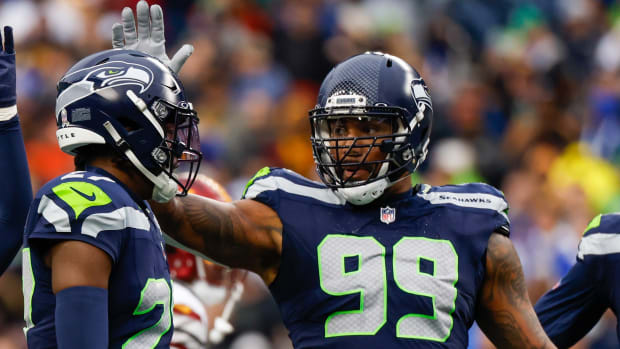MythBusters: Is it impossible to cover Rob Gronkowski?
In our “MythBusters” series, SI.com’s Doug Farrar uses tape, statistics and conversations with some of the NFL’s most knowledgeable voices to debunk storylines that have inexplicably gained traction. In this installment, Farrar debunks the notion (to a point) that Patriots tight end Rob Gronkowski can't be covered.
You have reached your limit of 4 premium articles
Register your email to get 1 more
MYTH: Rob Gronkowski is impossible to cover consistently, and all you can do is limit the damage.
REALITY: Gronk can be covered successfully, but it's going to take an unconventional strategy to do it.
Rob Gronkowski came into the 2015 season as the consensus best tight end in professional football, and he did nothing to diminish that reality in the opener against the Steelers, when he absolutely torched a Pittsburgh defense that was dealing with several communication issues under new defensive coordinator Keith Butler. Gronk caught five passes on eight targets for 94 yards and three touchdowns, leaving the Steelers' below-average defense with no answers.
Blanket Coverage: Why Grigson should be on the hot seat with Pagano
“Obviously he is a great player; he did a good job today,” Steelers safety Mike Mitchell said after New England's 28–21 win. “There were some plays that we let him have. I thought we a good week of preparations, I thought we were prepared, I thought we were better prepared for the tempo. There were a couple times we didn’t communicate well enough, didn’t get lined up, and they were able to get us.”
It was Mitchell who said before the game that Gronkowski is successful “when people don’t put their hands on him.” Linebacker Ryan Shazier added that the Steelers would do everything possible to upset Gronkowski's timing with Tom Brady.
“You just have to jam him up a little bit, mess with his timing,” the second-year linebacker said. “If you mess up their timing, they are really time-oriented. You have to mess up their timing and get in his face with pressure, then I feel we can slow him down a little bit.”
• BRANDT: Will NFLPA capitalize on Brady's win? | BENOIT: 10 Week 2 notes
Here's the first problem: Gronk is more physical than the average tight end, and when you press him, he can simply out-muscle you and adjust his timing. Here's the second problem: Pittsburgh was all over the place with their coverages, and didn't matter what they wanted to do—on several plays, they did nothing. This is the two-play sequence from the Pittsburgh 35-yard line that brought about Gronkowski's first touchdown with 11:16 left in the first quarter: a 19-yard pass, followed by the 16-yard score.
During his weekly segment on Boston radio station WEEI last Monday, Brady emphasized how important it is for the Patriots to avoid a predictable blueprint for defenses when they ask the eternal question, “How do we cover this Gronk guy?”
Importance of the left tackle is based on an old NFL, and it's time to adapt
“Every week we go in there and go ‘Well, they're going to do this to Gronk, and they're going to do this and have all these calls,’ ” Brady said, via MassLive.com. “For them to leave him uncovered a couple of times, look, it happens. And that's what we try to do as an offense. We're trying to put pressure on them, we're trying to get them to screw things up. We're not just trying to make it easy for him and, ‘This is where he's going to line up on every play, and this is all you've got to do to defend him.’ You've got to figure out ways—a multitude of ways—to get him open.”
The power of versatility
New England's offensive structure is the real killer when it comes to defending Gronk. Not only does the 6'6", 265-pound tight end use his physicality, determination and route knowledge to blow up just about every coverage concept thrown at him, he's also in a set of schemes that makes it just about impossible to deal with him the way defenses would like to—by covering him with as many guys as possible—and still address Brady's other targets.
The All-22: Six throws that display Marcus Mariota's quick NFL transition
“It's easy to say he lines up in a traditional tight end spot, and these are all the things we're going to do to him, but I think part of our offense has always been able to move guys around, put them in positions where [the defense] doesn't expect and see if they can figure it out on defense. They're trying to make calls and get their defense situated and they remembered all the coaching points they got all week and ‘This is how we're going to defend him,’ and you make a couple of plays in the game and those end up being huge plays.”
Gronkowski's biggest play against the Steelers was a 52-yard reception with 11:34 left in the game. This was another interesting example of personnel placement in that Gronk started out in the backfield and flared out to the slot. Pittsburgh didn't adjust at all, which is on them—that's why Gronk got a free release and a huge opening down the seam—but the design also highlights how the Pats create openings for a player who can take supreme advantage of whatever he's given.
So how do the Bills, who have to face Gronk and the Patriots on Sunday, deal with this? Rex Ryan's team is better-equipped than most to take care of this. They can bring pressure with their front four, allowing far more diverse coverage concepts in the back seven.
The bracket coverage myth
Conventional wisdom says that the best way to cover Gronk is with a bracket: Start him off with a bigger and more physical player to press him and throw him off his route at the line, then have a faster defender downfield when Gronk recovers and starts into his route.
It's a nice thought in theory, but two harsh realities tend to intervene. First, even if you're successful in bracketing Gronk like that, and Rex Ryan has said he may use up to three defenders at times, you're still leaving openings for Brady's other targets. Second, if you're going to use a linebacker or defensive end to pull him off his route at the line, the Patriots have devised a seemingly fool-proof counter to that idea: They split Gronk wide as an isolated receiver to force one-on-one matchups. A lot of teams do this with their tight ends, but few, if any, are more successful with this concept than the Pats.
Start 'Em, Sit 'Em: How to set your fantasy lineups for Week 2
According to charting stats assembled by Kevin Duffy of MassLive.com, New England split Gronkowski wide on 20.4% of Brady's pass attempts last year, and the uptick in production was staggering—with Gronk split wide, Brady completed 112 of 146 passes for 1,043 yards, eight touchdowns and no interceptions. Now, not every ball was thrown to Gronk when he was split wide, but that's part of the problem for defenses. Flaring him to the boundary of the formation creates seemingly impossible matchup issues. New England called a pass on 150 of the 154 plays in which Gronk was split wide, so opponents know what's coming when this happens, and they still can't stop it. And for most teams, splitting him wide means that you're not going to be able to beat him with a bracket in which a bigger player wrestles him at the line and a more athletic defender takes him through the route.
Rex Ryan's best chance
To see how Ryan is using his new personnel in Buffalo, I dialed up the Bills' 27–14 win over the Colts in Week 1. Ryan's defense limited Andrew Luck to 26 completions in 49 attempts for 243 yards, two touchdowns and two interceptions—and one of those touchdowns came with less than six minutes left in the game, when things were very much decided. The Colts' first offensive play game me a bit of insight into how the Bills may try to deal with Gronk when he's split wide.
This is an eight-yard run by Frank Gore, but watch how the Bills covered Colts tight end Dwayne Allen, who is split wide to the left: They didn't move their coverage around. They put linebacker Manny Lawson out wide, believing that Lawson could take Allen one-on-one. Not a strategy that's going to work against Gronk, but having a linebacker who's already confident in his ability to cover out on the edge could be step one of Ryan's Gronkowski plan. Step two might be cornerback Stephon Gilmore, Buffalo's best coverage player, who may be tasked to move around at the second level with Gronk, leaving Brady's other targets in the hands of Buffalo's other pass defenders. On Tuesday, Gilmore said that he was all in with that concept.
“I hope I get Gronk, to be honest with you,” he said. “We’ll see what the coaching staff says. Because I know the ball’s going to him. He’s a bigger guy so it’s not like I’m going inside on a smaller guy. But like I said, it’s whatever the coaches want me to do to help this team win.
“I want him.”
Huddle Up: A conversation with 49ers left tackle Joe Staley
Former Patriots safety Rodney Harrison espoused a similar strategy on NBC Sports' Pro Football Talk Wednesday evening.
“No one's been able to successfully cover him over the course of the seasons,” Harrison said. “The main thing that stands out to me is the size difference. Stephon Gilmore is 6'1" and about 190 pounds, and Rob is 6'7", 270. He's going to need help, because Rob is just so big and so athletic. I think what you do is, you get your linebacker—your most athletic linebacker—and you, right before he rushes, you're jamming him in his chest and slowing him down. Then, you get a guy like Stephon, who has the height at 6'1", and the athleticism, to move around with Gronkowski downfield.”
On Wednesday, Bills defensive tackle Kyle Williams put the Gronk challenge succinctly.
“You’re talking about the best tight end in the league. He can run, he can block, he can catch the ball, run after the catch, he does a lot of dangerous things in the red zone, you can split him out and get him the ball, so he’s somebody you really have to account for on every given play and you have to identify him and have to double him up when you can, but you also have to ask guys to hold up when you need bodies other places, so he’s a tough matchup for anybody and we have to be ready for it.”
NFL Power Rankings Week 2: Patriots stay on top; Colts, Ravens tumble
Ryan wasn't going to give away any strategy, but it's clear he's going to be more proactive than Pittsburgh's coaches were.
“He is hard to cover, there’s no question about that,” Ryan said. “I mean, shutting him down and all that … this dude, he’s gonna make catches, there’s no question about it. But you just don’t want him to go crazy on you. Three touchdowns, whatever it is [against Pittsburgh]. I mean obviously you’re trying like hell to eliminate that. But is he as big of challenge as you’ll face in the league as a tight end? Absolutely he is. His size, his speed, his strength. I don’t know, this just in: He’s pretty good.”
As the old sports cliché goes: You can't stop Gronk, you can only hope to contain him. And you have to contain him in a way that doesn't leave you open and vulnerable to everything else in New England's offensive arsenal. The combination of pressure with four rushers (which the Bills can do) and unconventional multi-coverage concepts (which the Bills can also do) could be the key.



































